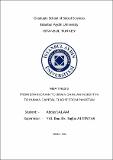Please use this identifier to cite or link to this item:
http://hdl.handle.net/11547/1838| Title: | FROM BRAIN DRAIN TO BRAIN GAIN: AN INSIGHT IN TO HUMAN CAPITAL FLIGHT FROM PAKISTAN |
| Authors: | Salam, Abdus |
| Keywords: | Brain drain Brain gain Externalities Migration and Remittances Beyin göçü Beyin kazanç Dışsallıklar Göç ve Para göndermeler |
| Issue Date: | 2014 |
| Publisher: | Graduate School of Social Sciences Istanbul Aydin University |
| Abstract: | Brain drain (BD), also known as Human Capital Flight (HCF) refers to migration of skilled and or educated from developing to developed countries. In actual the phenomenon is no more one way from the developing to developed, rather many developed countries are experiencing the same like from Eastern Europe to west and north. The term first coined by the British Royal Society during mid 20th century, then referred to the outflow of scientists and technologists to USA and Canada. The word brain refers to any special expertise and the drain refers to its exit in one direction and rate of exit is considered more than normal. The research on the subject has different social and economical aspects. The phenomenon has taken a new dimension in the last two decades referring it to brain gain, brain circulation, brain exchange etc where in, it’s always used negative connotation is redirected towards its potential gains for the exporting countries. Pakistan is a developing country and has seen this phenomenon since its inception in 1947. As per Bureau of emigration and overseas employment Pakistan, a total of 6.9 million skilled/educated Pakistanis have been registered with government of Pakistan as employees abroad till September, 2013. But the actual figures are estimated to be quite high as many emigrants could not be registered by the bureau. As per World Bank migration and development brief 21 issued in October 2013, the remittances made by these Pakistani expats during 2013 (USD 15 billion) put Pakistan on 8th most remittances recipient country in the world. These remittances are expected to be 137% of foreign exchange reserves of Pakistan. The migration from Pakistan is mainly attributed to poor economical conditions, urge to acquire better living standards, uncertain political environment, better higher education and lately the deteriorating security environments in the country. The study has been taken by qualitative and quantitative methods of research. By conducting an email survey (using snow ball sampling technique) of highly educated and skilled Pakistani expats it tried to ascertain the positive or negative externalities of BD on Pakistan. These educated people are mostly professional in their own fields and settled abroad in four different regions with majority in OECD and Middle East which are the major target areas for Pakistani emigrants. With an intention of combining the results of qualitative and quantitative research method, methodology adopted was use of SPSS tools to ascertain the results of the primary research. Descriptive analysis by calculating the frequency tables and group analysis by doing T test and one way Anova helped in understanding the findings and analysis. The findings revealed that though the phenomenon is increasing but it has more positive externalities than negative. This implies that in this increasing trend the measures required at national level, to take the benefit of this migration trend are direly needed otherwise it will be too late to make use of this ever increasing human aspect. |
| URI: | http://hdl.handle.net/11547/1838 |
| Appears in Collections: | Tezler -- Thesis |
Files in This Item:
| File | Description | Size | Format | |
|---|---|---|---|---|
| 376750.pdf | Tez dosyası | 2.41 MB | Adobe PDF |  View/Open |
Items in DSpace are protected by copyright, with all rights reserved, unless otherwise indicated.
